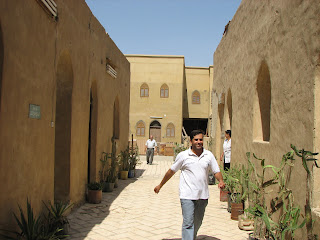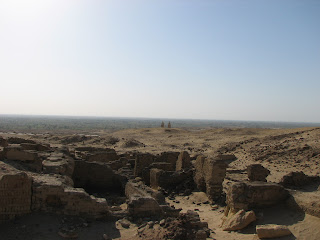
You probably knew this post was coming at some point during our year here. :) Egyptian traffic is crazy... not so much due to aggressiveness, though that is a factor, as much as the variety of transport you encounter. On one street, you can simultaneously encounter not only a swarm of cars, microbuses, taxis, and large trucks weaving in and out trying to pass each other, but you'll pass a donkey pulling a cart on your right, and a motorbike on your left running
against the traffic, plus there are always people trying to cross the street...and they aren't shy, even when they have their small children with them!
This is normal. The following photos show some of the sights which have made us point and say "Take a look at that!" :)
Sheep:

Water buffalo:

A propane tank...certainly not the largest load we've seen on a motorbike. My favorite was a large pane of glass.


These microbuses serve as taxis, either in a city or between cities. They are virtually always packed full of passengers so all the luggage goes on top.


Camel stop:

I wasn't here for very long before I became aware of the word "Insha 'allah" which means "God willing". Egyptians' everyday speech is peppered with it. I'll tell Samia "Ok, then I'll see you tomorrow"; she always answers "Insha' allah".
To Hamdi, the Gardener: "OK, so you'll come two times a month??"
Hamdi: Insha' allah
To Samia: "I hope your son's school year will be better this year"
Samia: Insha' allah
You get the idea. It's a passive attitude towards life which, as a Christian, I actually agree with to a certain extent....a constant reminder that our lives belong in God's hands, not our own. But it's interesting to me how this concept has created a culture of passivity. David was briefed about this before he came over; it is very difficult to do long-term planning with the Egyptians he works with.....even short-term planning for that matter. He will ask another pilot "So are you going to do a maintenance flight on 179 today?" Answer: "Insha 'allah" It is difficult to work with that bc it's not really an answer. David is left wondering, "Well, is he planning to do it or not?? Because if he's not going to get to it, I need to do it since it's scheduled for tonight's flight." David's also found that, at work, saying "Insha 'allah" is a way around saying no to a question and disappointing the other person.
This mentality of our fate not being in our own hands permeates everything here. How to enforce a mandatory seatbelt law, for example, when the general populous feels that if it's their time to go, then wearing a seatbelt's not going to matter?
Actually in one of our first taxi rides (taxis here deserve their own blog entry! :) we had a driver who wasn't aggressive as much as just clueless. The way he leaned forward, it looked like he couldn't really see and as he drifted aimlessly from lane to lane or simply straddled them, he left a wake of angry honking drivers behind him of whom he seemed completely unaware. I truly thought we were going to have an accident. I leaned over to David, which was easy to do since the seatbelts didn't work, and whispered "Insha 'allah". :)









































